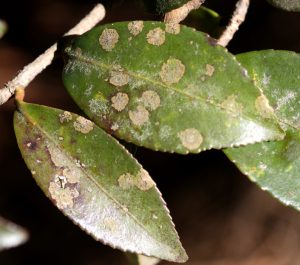Every summer we get a flood of emails and samples from residents who have problems with spots on their plant’s leaves.
Florida summertime weather is perfect for fungi and a variety of insects who may be to blame for this problem. Sometimes herbicides can drift in the breeze and cause spotting on leaves. But every once in a while, we receive a photo of a species of algae that is parasitic to plants.
The algae Cephaleuros virescens, also known as green scurf, is the only species that attacks plants in Florida. It causes distinctive raised patches on the leaves of a variety of landscape and fruit plants. This disease has a large host range, including camellia, magnolia, holly, Indian hawthorn, and even fruits such as blackberries. The most common sign is rough greenish patches on the upper side of the leaves, but this algae can attack stems and trunks also.

Joey Williamson, ©2010 HGIC, Clemson University
The recommended control for green scurf is a copper based fungicide, but many times you can just trim off the affected parts of the plants. Disposing of fallen leaves and avoiding irrigation that wets the leaves is important to limit the spread of the algae to other leaves.
Header picture credit: Edward L. Barnard, Florida Department of Agriculture & Consumer Services, Bugwood.org.
 2
2
